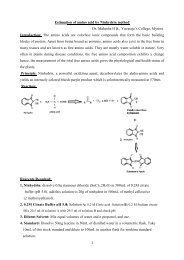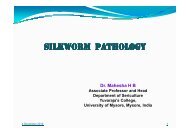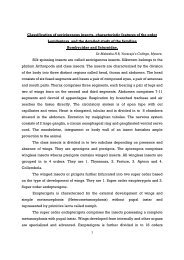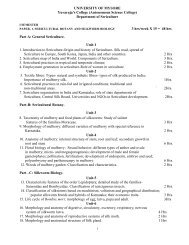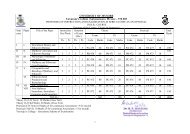silkworm grasserie and pebrine for open elective
silkworm grasserie and pebrine for open elective
silkworm grasserie and pebrine for open elective
You also want an ePaper? Increase the reach of your titles
YUMPU automatically turns print PDFs into web optimized ePapers that Google loves.
Infection mostly takes place through feeding of polyhedra contaminated mulberry leaf,<br />
rarely through wounds. Heat, cold <strong>and</strong> chemical treatments have also been known to induce<br />
this disease. Factors inducing the outbreak of this disease are high temperature <strong>and</strong> humidity,<br />
their sudden fluctuations, bad ventilation in the rearing room, ineffective disinfection of rearing<br />
room <strong>and</strong> equipments <strong>and</strong> feeding of tender leaves during late instars. Inadequate larval<br />
spacing, starvation <strong>and</strong> excessive moisture in the rearing bed have also been known to<br />
contribute towards the outbreak <strong>and</strong> spread of the disease.<br />
Symptoms: During early part of the disease no symptoms are noticed except the worms<br />
being slightly sluggish. Initially the skin shows oily <strong>and</strong> shining appearance (Fig. 2). As the<br />
disease advances the skin becomes thin <strong>and</strong> fragile <strong>and</strong> the body becomes milky white with<br />
intersegmental swellings (Fig. 3). The fragile skin is prone to rupture easily, liberating the<br />
liquefied body contents containing innumerable number or polyhedra which become the source<br />
of secondary contamination. Another characteristic symptom or this disease is<br />
that the larvae become restless <strong>and</strong> crawl aimlessly along the ridges or rims of rearing trays,<br />
(fig 4) subsequently falling on the ground <strong>and</strong> dying. Death takes place alter infection in about<br />
4-5 days in the young larvae <strong>and</strong> 5-7 days in the grown-up larvae. Diseased larvae lose the<br />
clasping power of abdominal legs except the caudal legs by which it hangs with<br />
the head downwards (Fig, 5). If the infection is early the worms fail to spin the cocoons <strong>and</strong><br />
die, whereas if the infection is late they are able to Spin the cocoons but die inside producing<br />
melted cocoons.<br />
2



